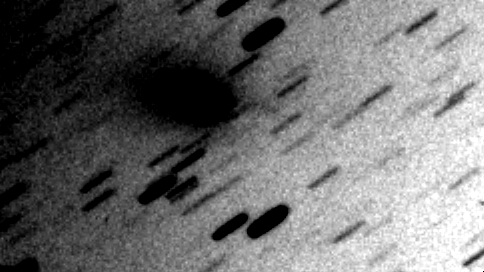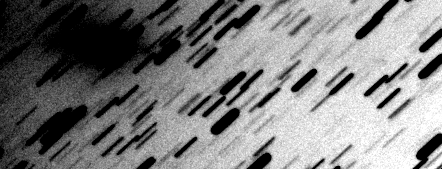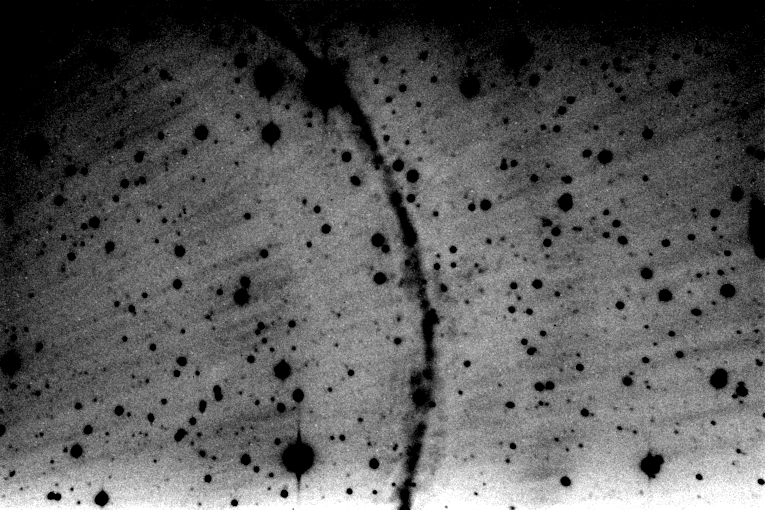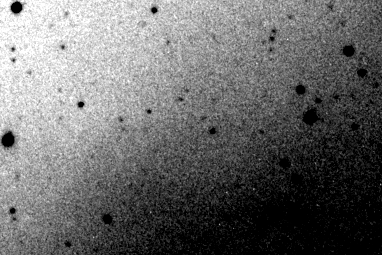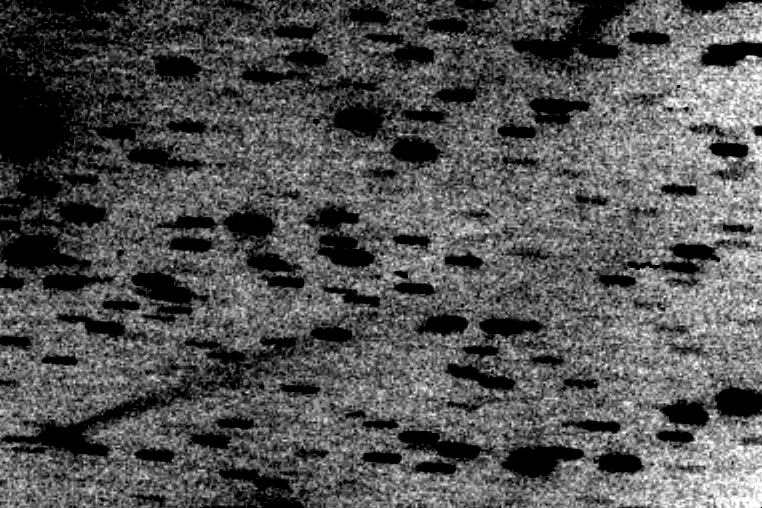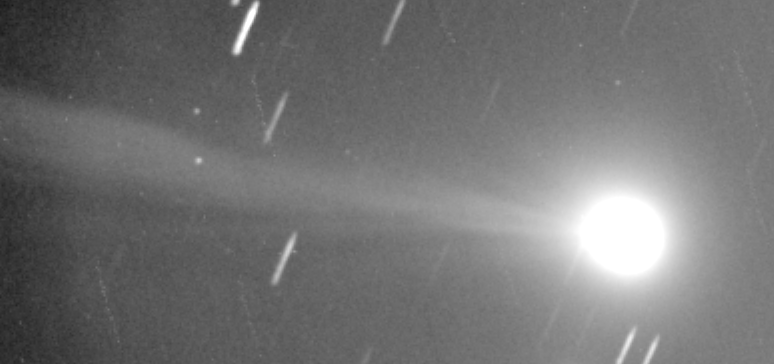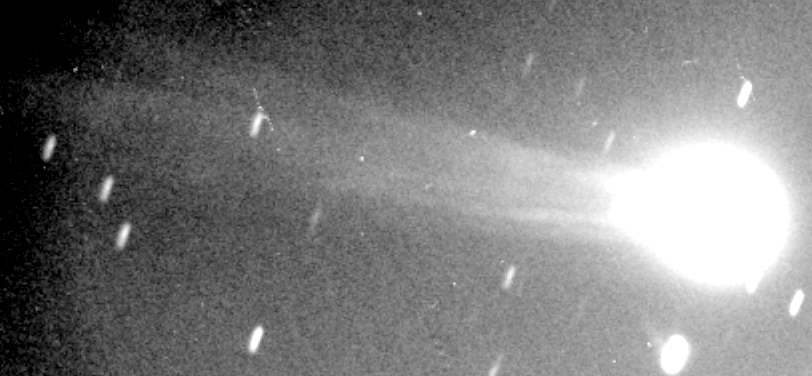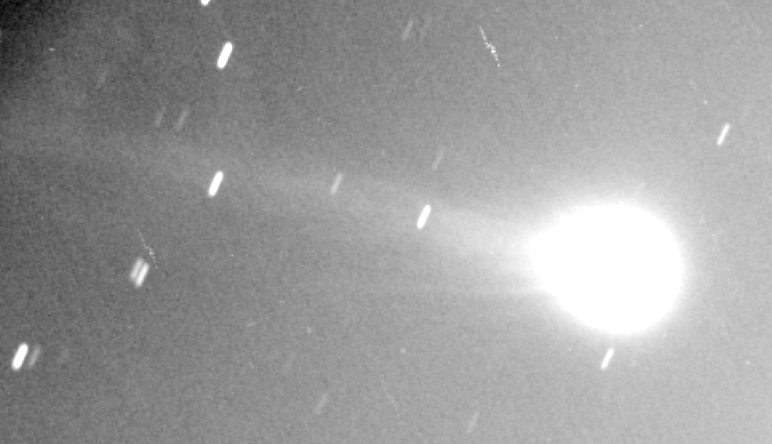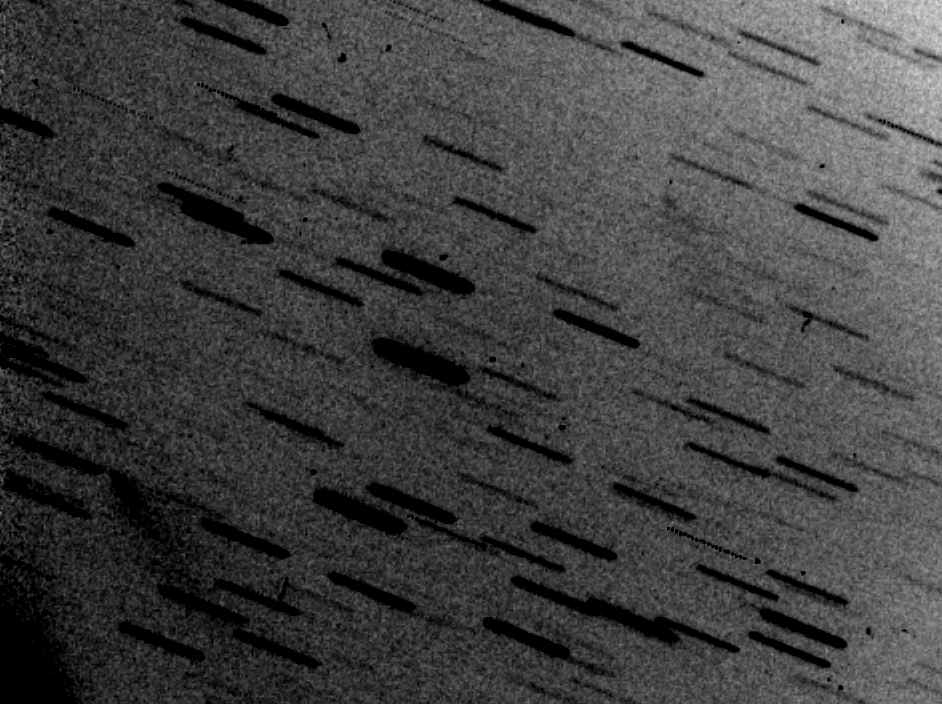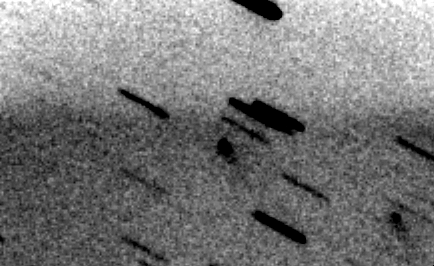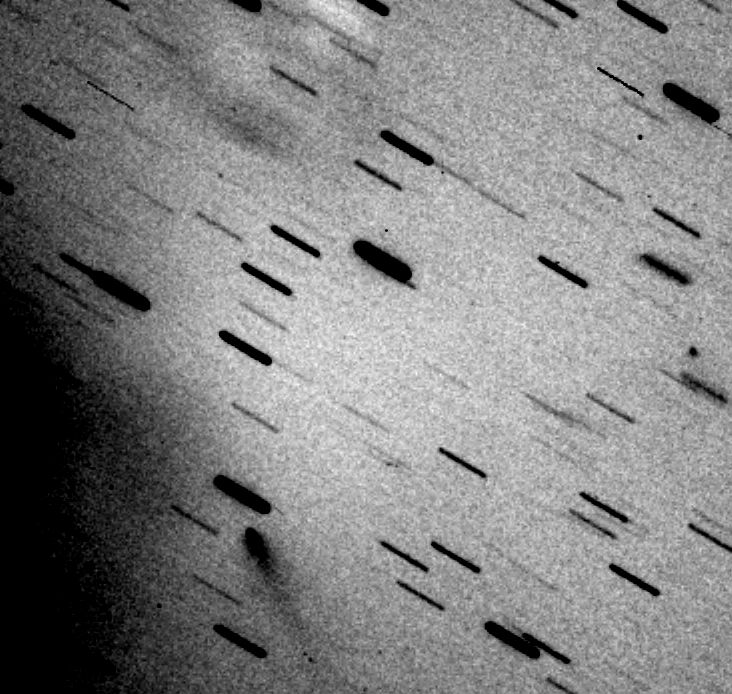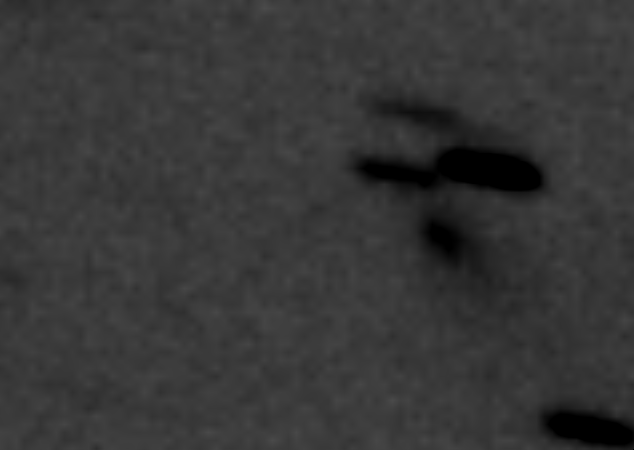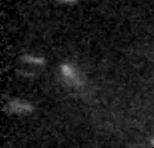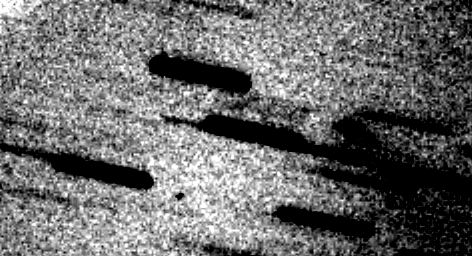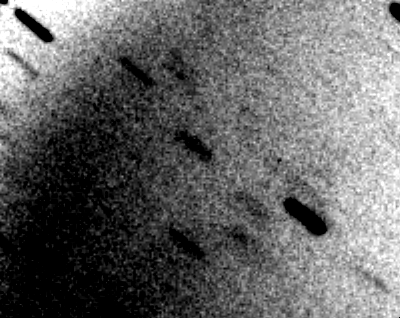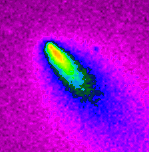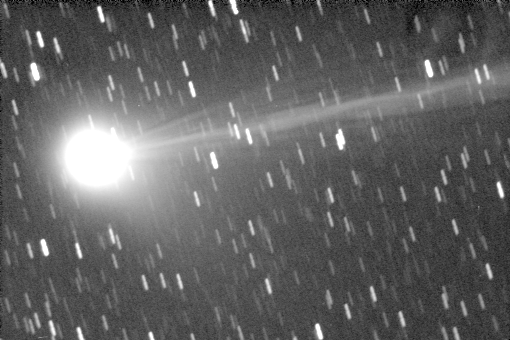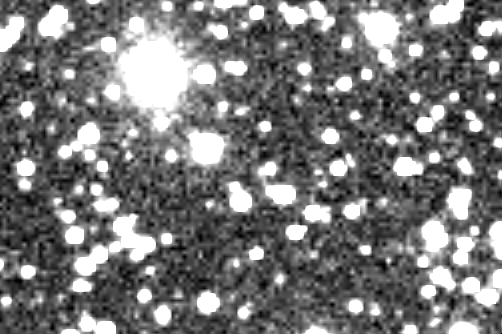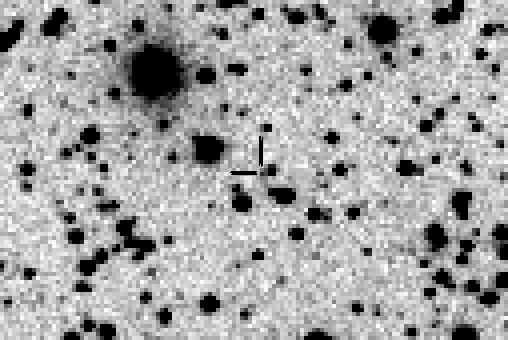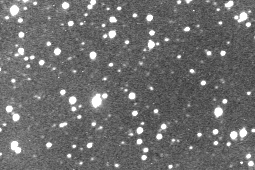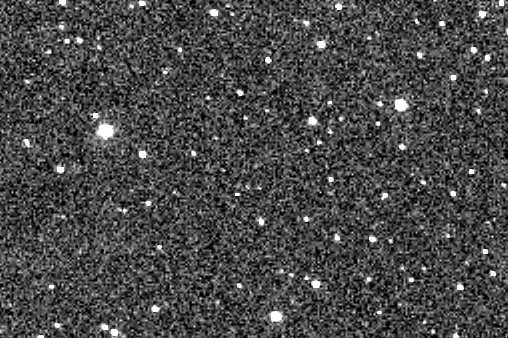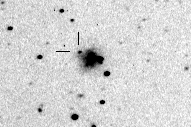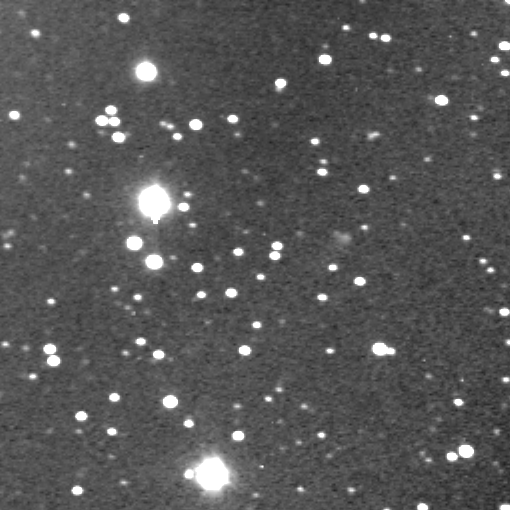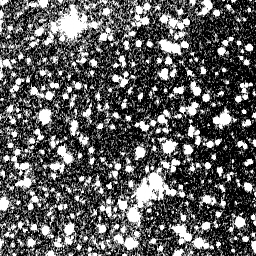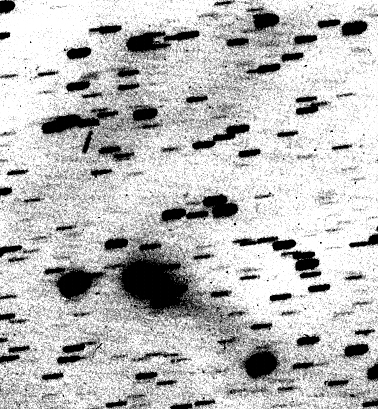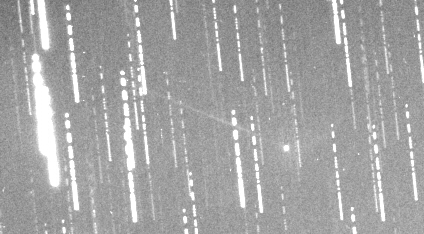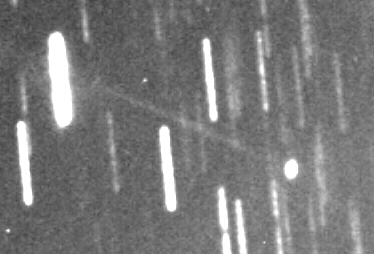Discoveries from the Cordell-Lorenz Observatory
Comet Giacobini 205P fragments a and b.
2008 10 01 UT
Stacks of 15 x 120 sec, 30 minutes per frame. 12 inch, f/2.5 telescope. Images by Dr. D. T. Durig and A. Takebuchi.
Image uploaded on: 2008-10-01 06:43:18
Comet Giacobini 205P, fragments a, b, and c on 9/24 UT. Fragment b is near the parent body (fragment a) on the left of the image, but there are background MW stars interfering on several frames. Fragment c is on the right side of the image and can be seen in all four frames. Twelve inch (0.30 m f/2.5) telescope and stacking 24x120 seconds (48 minutes!) for each frame of the animation. Image by Dr. D. T. Durig.
Image uploaded on: 2008-09-24 01:51:25
Animation showing both new companions to Comet Giacobini 205P. First companion is right next to the main comet body on the left side of the frame and the second companion is near the right edge of the frame. Twelve inch telescope (0.3 m @ f/2.5). Stacks are 30x120 seconds for a total of 60 minutes per frame, stacked on the motion vector of the main comet body. Images by Dr. D. T. Durig on 9/22 UT.
Image uploaded on: 2008-09-22 19:41:42
Precovery confirmation images of first new companion to Comet Giacobini 205P. Stacks are 50x30 sec for a total exposure of 25 minutes per frame. Images by Dr. D. T. Durig on 9/17 UT
Image uploaded on: 2008-09-22 19:40:19
Discovery images of first new companion to Comet Giacobini 205P. Stacks are 15x120sec for a total time of 30 minutes per frame tracked on the motion of the parent comet body. Twelve inch telescope (0.30 m @ f/2.5). Images by Dr. D. T. Durig, Jake Sberna and Kyle Hatchett on 9/19 UT.
Image uploaded on: 2008-09-22 19:38:43
GRB 070223 field
85x120 sec for a total exposure of 170 min
limiting mag of ~21.8
No afterglow detected.
0.3 m f/3.4 SCT
Image by D. T. Durig, J. K. Bates, T. R. Williams and T. E. Stegall
Image uploaded on: 2007-02-23 03:44:40
Comet C/2005 E2 McNaught
2007 02 19 UT
FOV 28x28 arc minutes
0.3 m SCT at f/9.7
STL-1001E CCD
Three frame animation of 15x120 sec stacks ( each frame is a combined 30 minutes of exposure).
Tail goes almost to the edge of the frame.
Full tail length over 24 arc minutes !
Image by D. T. Durig
Cordell-Lorenz Observatory
Image uploaded on: 2007-02-19 03:53:20
We started imaging as soon as it was dark enough and we could get telescope focused, at 00 55 57 UT on 2007 01 31. We tok a total of 120 frames but only the first 75 good frames were used in the stack due to the low altitude of the last frames. We can clearly see the candidate from the VLT image but we get a position of RA 02 28 01.35 Dec +11 41 06.0 and a magnitude of 21.1 +/- 0.3 mag with a SNR of 4.6.
Image by D. T. Durig, C. C. Grigsby and J. M. David
Image uploaded on: 2007-01-30 23:57:21
GRB 070125
2007 01 29 UT
07 h 39 m 56 s UT mid exposure
21.5 +/- 0.2 mag
148 x 120 sec stacked image
Moon was bright so background looks bad, but afterglow is clealry detected at SNR 3.1
Image by D. T. Durig
Image uploaded on: 2007-01-29 04:59:44
GRB 070125
2007 01 27
05 hr 42 min 49 sec UT
07 51 17.74 +31 09 04.1
120 x 120 sec
for four hour total exposure
19.6 mag
half frame crop
Image by D. T. Durig, D. S. Hardage, and N. M. Haymond
Image uploaded on: 2007-01-27 02:34:08
SN2007J in UGC1778
30x120sec
half frame crop
17.2 mag
Image by D. T. Durig
Cordell-Lorenz Observatory
Sewanee, TN
Image uploaded on: 2007-01-20 19:56:29
GRB061217 7.2x7.2 arc min FOV.
25x120sec exposures co-added.
Possible afterglow at
RA 10 41 40.7 DEC -21 08 50 +/- 2 arc sec
at about 20 +/- 0.5 mag
Image uploaded on: 2006-12-17 06:21:00
Animation of single 10 second long exposures, taking every 10th frame. In these individual images features can be seen moving along the tail, blown by the solar wind away from the comet.
Images by Dr. D. T. Durig
Image uploaded on: 2006-10-26 21:58:46
Stack of 30x10sec images of Comet SWAN 2006 M4 from 10/25 UT near 0 h. Jets and streamers show averaging from motion during stack.
Image by Dr. D. T. Durig
Image uploaded on: 2006-10-26 21:56:54
New 17th mag comet in Gemini
P/2006 U1 ????
Stacks of 20x30sec, stacked with object motion vector.
Tail is longer than 10 arc minutes in longer stacks and just about crosses frame in images shown here.
Image by Dr. D. T. Durig
Image uploaded on: 2006-10-21 06:11:36
Comet Levy 2006 T1
2006 Oct 5 ~9:30 UT
120x30 sec exposures stacked on comet's motion vector.
Total Mag about 11.1
Image uploaded on: 2006-10-05 06:14:54
Comet SWAN 2006 M4
2006 Oct 5 ~10:35 UT
40x30 sec exposures stacked on comet's motion vector.
Total Mag about 7.1
Image by D. T. Durig
Image uploaded on: 2006-10-05 06:13:22
Comet SWAN 2006 M4
2006 Oct 4 ~10:30 UT
17x30 sec exposures stacked on comet's motion vector.
Total Mag about 6.6
Notice the nice forked structure in the tail !
Image by D. T. Durig, E. J. Wilson and P. A. Hiller.
Image uploaded on: 2006-10-04 06:07:52
Comet SWAN 2006 M4
2006 Oct 3 8:20 UT
14 x 30 sec exposures tracked on the comet so stars are streaks. Coming soon to an evening sky near you !
Image uploaded on: 2006-10-03 05:57:01
Comet SWAN 2006 M4
2006 Sept 29 ~10 h 30 m UT
20 x 30 sec stacked on comet
Total Mag ~7.2
Rotated CCW so North is left and East is down.
Image uploaded on: 2006-09-30 04:32:19
Comet SWAN 2006 M4
2006 09 26 UT ~ 5 24 AM CDT
19x30 sec exposures stacked on comet so that stars are streaks. About 8th mag and visible in binoculars !
Image uploaded on: 2006-09-27 05:56:51
GRB060819 region. No afterglow immediately visible. 25 x 120 sec for 50 minute total exposure. Region was at a low 30-25 degree altitude and dawn was approaching. Region is in central Cygnus with lots of background MW stars.
Image uploaded on: 2006-08-19 05:38:08
Quarter frame crop ( 128x128 pixels, 7.2x7.2 arc min )centered near reported GRB060807 OT. 150 x 30 sec for total exposure of 75 minutes. Acumulated hot pixels at 1 o'clock near center of frame and near top center are artifacts. No afterglow observed to a limit between 20 and 20.5 mag.
Image uploaded on: 2006-08-08 01:27:08
New component BN of Comet 73P image from 5/6 UT. First observed 5/2 ( see below ) as a companion to component R without much of a tail visible, the tail is now more fully developed. It is starting to show evidence of breaking up. How long will it survive ?
Image uploaded on: 2006-05-11 22:12:45
New component of Comet 73P near H, about 3 or 4 arc min away at PA 240. New component almost matches compoent H in brightness. It almost seems that the new component has already broken in two. There is another much dimmer component about 15 min away at PA ~300 not visible in these images. Images by Dr. D. T. Durig and Byron Greene.
Image uploaded on: 2006-05-02 07:19:13
New 17th magnitude component of Comet 73P located about 10 arc min west from component R at PA 300. Motion vector is essentially the same as R. Just a minor hint of a tail, but perhaps it may develop soon. Images by Dr. D. T. Durig and Byron Greene.
Image uploaded on: 2006-05-02 06:56:05
Eastern most component AT of Comet 73P imaged on 4/28 UT. Currently located six degrees east of bright component C and much dimmer at 18th mag. Perihelion for this component will be the earliest of any yet announced on June 6.22, 2006.
Image uploaded on: 2006-04-28 07:33:53
New images from 4/28 UT of 73P component AS showing its fragmentation. The pieces are still all lined up in the tail, but at least three or four are distinct enough to measure.
Image uploaded on: 2006-04-28 07:26:31
Same new 17/18th magnitude fragment AS as below, but a negative image and moving away from background stars.
Image uploaded on: 2006-04-27 02:45:18
New 17th mag component AS of Comet 73P almost 4 degrees East of component C. Very fast mover at 4.1 arc sec per minute at PA 81. Images are stacks of ten 30 second exposures stacked with the motion vector of the comet compoent.
Image uploaded on: 2006-04-27 02:43:16
Brighter new component AP of Comet 73P about 90 arc minutes East of the rest of the components C, AF, and AR. Stacks of 40 thirty second long exposures added with a motion vector of 4.25 "/min at PA 79 degrees. Object moves in front of a group of stars near mid-frame, but can be clearly seen. Object first noted by Eric Christensen on MPML list.
Image uploaded on: 2006-04-27 02:41:01
Animation of component P and nearby component AO of Comet 73P from 4/19 UT. Objects are between 19.5 and 20.5 nuclear magnitude. Each image is a stack of 40 different 30 second frames stacked with the motion vector expected from component P, which is about 2 arcsec per minute at a position angle of 50 degrees. There is a background flat field problem that causes the dark upper left hand corner of the image. This component of the comet is about a quarter of a degree away at PA 106 degrees from the much brighter component B, which is now visible in good binoculars from dark sites.
Image uploaded on: 2006-04-27 02:39:07
Animation of component P and nearby component AO of Comet 73P from 4/18 UT. Objects are between 19.5 and 20.5 nuclear magnitude. Each image is a stack of 40 different 30 second frames stacked with the motion vector expected from component P, which is about 2 arcsec per minute at a position angle of 50 degrees. There is a background flat field problem that causes the dark upper left hand corner of the image. This component of the comet is about a quarter of a degree away at PA 106 degrees from the much brighter component B, which is now visible in good binoculars from dark sites.
Image uploaded on: 2006-04-27 02:37:31
Single 30 sec exposure from 4/20 UT showing fragment AQ separating from fragment B of Comet 73P. Image is log scaled and used a rainbow color table.
Image uploaded on: 2006-04-26 02:45:21
Comet Pojmanski 2006 A1, taken March 5,2006 between 4:30 and 5:15 AM. Each frame is a stck of ten 30 second images, stacked with the comet's vector of motion so that the comet is still and the stars steak out. Comet is visible in binoculars in the morning sky in March.
Image uploaded on: 2006-03-09 23:24:16
One of our recent discoveries, 2006 BW139, which was first observed by Byron Greene on Jan 30.
Image uploaded on: 2006-03-09 23:19:59
Animation of GRB051109a afterglow fading. Frames are at about 30 minute intervals from 2:45 UT until 5:45 UT. FOV is about 4x6 arc min. Afterglow fades from 18.7 to dimmer than 20th magnitude. Images by Dr. D. T. Durig.
Image uploaded on: 2005-11-09 15:09:31
GRB051109 at 2:50:46 UT on 2005 11 09 observed at about 18.7-19th mag. FOV is about 4 by 6 arc min. Median addition of 4 consecutive 300 second exposures. GRB afterglow is located very near a 17.8 mag star located at 22 01 14.6 RA +40 49 25 DEC. Image by Dr. D. T. Durig of the Cordell-Lorenz Observatory of The University of the South.
Image uploaded on: 2005-11-08 21:21:08
GRB051028 afterglow at about 12 hours post HETE detection. Sum of 12 x 300 sec for a total of one hour exposure. Afterglow is about 20.6 to 21.0 mag. Image by D. T. Durig and E. B. Caton.
Image uploaded on: 2005-10-29 04:48:22
2 hour exposure ( 24 x 300 sec ) showing the afterglow of Gamma Ray Burst 050922C. It faded from 19.1 mag to 20.1 mag during these two hours of exposure.
Image uploaded on: 2005-09-22 23:36:57
Large Image Upload Working!
3MB+ File
30FPS
Image uploaded on: 2005-09-21 18:41:36
SN 2005dz
6x300 sec
6.7x4.5 arc min
17.9 mag
Image uploaded on: 2005-09-12 07:02:04
Interesting object from 9/4 UT. What is it ??? Where is it now ?????????????
Image uploaded on: 2005-09-06 02:04:35
GRB021004
Image uploaded on: 2005-06-29 16:15:32
GRB050525- sum of 75 individual 120 sec images centered near 8 13 UT 0n May 25, 2005, approximately 5 hr 20 min after burst detection and between 18 and 19th magnitude. Field of View is 12x12 arc min.
Image uploaded on: 2005-06-15 15:05:50
This is an image of Comet 32P Comas Sola taken by Mary Alice Mathison (C07) on November 9th, 2004. Twelve individual five minute exposures were added together with the motion vector of the comet so that the stars are streaks and the moving comet is not smeared out by its motion. The odd streak around 11 o'clock from the comet is a Near Earth Asteroid, 2004 PU103. It's motion was different from the comet so it was streaked in a different direction than the stars. The tiny dot above the cluster of 5 streaked stars above the comet is one of our discoveries, 2004 VJ65. It's motion was very similar to the comet so it appears as a dot. Another of our asteroid discoveries, 2004 VR65, is also in the frame but much dimmer and not moving nearly the same as the comet so it can be detected in this view. Four more new asteroids were located just outside the frame as we did follow-up observations on these two discoveries on other nights later in the week: 2004 VS65, 2004 VH75, 2004 VP74 and 2004 VD78.
Image uploaded on: 2005-06-15 15:05:47
Comet 2004 TU12- The Asteroid that became a Comet for three days- this is day number three.
Image uploaded on: 2005-06-15 15:05:44
Comet 2004 TU12- The Asteroid that became a Comet for three days- this is day number two.
Image uploaded on: 2005-06-15 15:05:41
Gamma Ray Burst 050502a which has been determined to have occurred approximately 12 billion years ago. Dim star at 11 oclock from star in center of frame.
Image uploaded on: 2005-06-15 15:05:38
